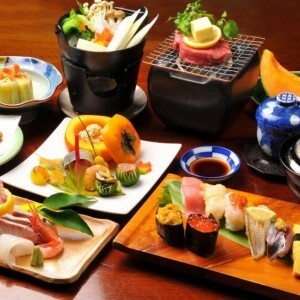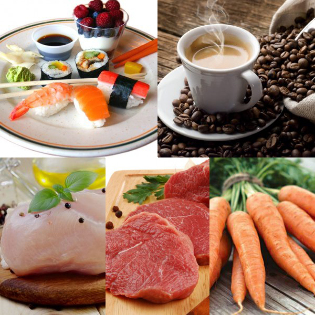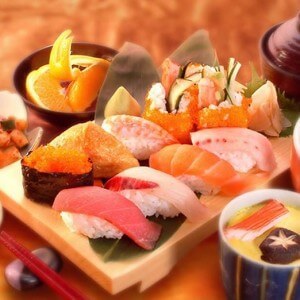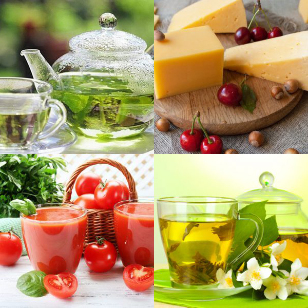
The Japanese diet is a low-carbohydrate and low-calorie diet developed by Japanese nutritionists. Its protein menu allows you to lose about 10 kg in 2 weeks.
Nowadays, overweight has caused many people to call it an ultra-fast lifestyle. We are eager to live, eager to work, eager to eat. . . Moreover, we often eat out, as they say, God will send it. In the 21st century, God is sending us hamburgers, hot dogs, cheeseburgers and sodas more and more. . . "What to do? Don't waste precious time eating lunch or something in a restaurant? -When the business is "on fire", yourselfCooking in the kitchen? ! They say that here, the entire successful world lives like this, with nothing. "This excuse is used by a large number of people and some people live an active lifestyle. When the jeans you don’t like don’t fit, when you have to buy a longer belt, between the seductive skirt with a tight waist and the ugly invisible style with elastic bands, we choose the second one, and then, of course, It's time to make a new excuse. Well, actually-all of this is certainly not caused by malnutrition, but just. . . a thick bone. Yes, yes, there is nothing to do, a thick bone-indeed, very cunning. And it grows in the beginning-nothing can stop it.
Now, we turn our attention to Japan, which is a huge land of opportunity, with the highest level of technological development and an incredible pace of life. It seems that if someone does not have time to stop for the right meal, it is just like a Japanese. But, surprisingly, you rarely encounter "cheeky" among Japanese residents. . . So, what's the secret?
The fact is that Japanese snacks are low-calorie foods, rich in protein, almost free of fat and "bad" carbohydrates. The main principle of Eastern food tradition is temperance. Therefore, Japanese cuisine is known as one of the healthiest foods for the human body.
Taking into account the particularity of the oriental nutrition tradition, people have created a balanced and extremely effective diet, that is, the Japanese diet. In fact, there is almost no traditional Japanese food on this diet menu. But there are more combinations of protein, fat and carbohydrates, the quantity of which is sufficient for the body to receive everything it needs without causing the "thickening" of bones. There are several dietary options, but the most popular is Japan’s 14-day salt-free diet. Two weeks of proper "Japanese" nutrition will help "crude bones" lose more than 10 kg, effortlessly maintaining the results for several years.
The essence of Japanese food
Those who decide to go to "Japanese" must be patient and stay away from the usual diet for two weeks. For many people, diet seems to be a rather daunting challenge, but this effect will not last long. But the amazing results still exist for several years. It turned out that there was only two weeks of treatment for "Japanese women"-ten kilograms (sometimes even more-depending on the initial weight).
So what is the main secret? Why is the Japanese diet better for one week to lose weight than other nutritional systems? Even for those who have tried many other diets to no avail, what is the magical effect of losing weight?
All carefully selected products related to the diet menu-their combination speeds up the process of metabolism as much as possible. Therefore, it is very important to strictly follow all instructions and eat only designated foods instead of "improving". Its other products, even if at first glance they seem to be completely interchangeable. It is also recommended not to exchange the date of the menu.
For many women, when choosing food, her level of "hunger" is very important, because not everyone can compete with the willpower of the samurai, especially the ancient instinct of all living beings-hunger. This is why the fact that the two-week salt-free diet in Japan is not a "hungry" diet. By sticking to this, you won’t have to chew a cabbage for weeks, or drink low-fat kefir, curse yourself, people who are overweight, and people who are dieting. The menu of Japanese women contains interesting and delicious recipes. This diet is especially suitable for those whose breakfast usually only contains coffee. Lovers of meat and fish will not find it difficult. This is the best diet for them.
The essence of Japanese diet is easy to explain in two words-slow and efficient.
"Japanese" is a low-calorie protein and fiber diet. Reducing the carbohydrates to a minimum in your daily diet will force you to lose weight faster-requiring energy, the body begins to convert its own fat reserves into joules. But it is important to remember some other things: Japanese women’s diet does not saturate all the vitamins and minerals in the body. Therefore, it is strictly forbidden to go on a diet for longer than the prescribed time (no more than 14 days) to avoid completing the weight loss process on the hospital bed.
And, if you imagine a real Japanese, you can try Japanese sticks instead of the traditional European forks and spoons. They will not only convey the mythical spirit of the country of the rising sun, but also teach them how to eat slowly and divide it into small pieces. By the way, many diet supporters know this technique. Eating leisurely can deceive the body and make you feel full even after eating a few meals. In fact, this should be taught by the Japanese to lose weight.

Types of Japanese food
The Japanese diet is very popular among women all over the world, leading to a variety of options for this weight loss system. Especially the diet choices are well known:
- Japanese salt-free diet for 7 days;
- 13 days (the most common diet);
- 14 days (different from the previous 13 days of diet, only one day);
- Japanese women use green tea;
- Moriyama Naomi's diet.
Proponents of these technologies call their favorite version "real" Japanese women. Moreover, many landmines have been broken in disputes over the ownership of food. Some people think that Japanese nutritionists invented it, while others think that this system has nothing to do with the East. No matter who is the author of Japanese Diet, the most important thing is that it is effective. Its effectiveness has been experienced by millions of doughnuts on the planet.
The menu of the Japanese diet for weight loss includes calories, the lowest carbohydrate content, foods that do not contain salt, spices, sugar and sweets, and any alcohol, so the diet is considered strict. Since the body is under stress and forced to burn its own fat and calories, this helps the rapid breakdown of body fat.
7-day diet menu
The 7-day Japanese diet is a simple version of the traditional Japanese diet, but at the same time the 7-day diet is the basis of the entire diet.

Expected result: 3-5 kg left in the past.
Disadvantages: Since the body has not had time to adapt to the new metabolic system, the lifespan of the results cannot be guaranteed.
Day 1
The calorie content of the daily diet: 700 kcal.
Required products:
- black coffee;
- eggs;
- Fresh cabbage (Beijing cabbage/cabbage);
- Tomato juice (preferably freshly squeezed);
- Low-fat fish.
Breakfast:
- Black coffee-it is best to choose espresso, but it is best not to add sugar.
Lunch:
- Boiled eggs (can be 2);
- "Japanese" salad-fresh cabbage and a little vegetable oil, no need to add salt;
- A glass of tomato juice.
Dinner:
- Steamed fish-cod, cod, cod are ideal (parts not exceeding 200 grams);
- Japanese salad.
Day 2
The calorie content of the daily diet: 1000 kcal.
Required products:
- coffee;
- Rusk;
- Fish (fatty species);
- Cabbage;
- Vegetable oil;
- beef;
- Kefir.
Breakfast:
- coffee;
- Rusk-take a small piece, weighing about 30 grams.
Lunch:
- Fish, fried or stewed-in order to increase the types of fatty acids and other consumption, it is best to use catfish, salmon, black halibut. Not more than 150 grams in total;
- "Japanese" salad.
Dinner:
- Beef-cook about 200 grams. Eat without salt;
- Kefir-You can skim, but not more than 200g glasses.
Day 3
The calorie content of the daily diet: 1000 kcal.
Required products:
- coffee;
- Zucchini/Parsnip;
- Apple;
- eggs;
- Veal;
- Cabbage;
- Vegetable oil.
Breakfast:
- Black coffee-don't forget to pause the sugar.
Lunch:
- Zucchini (large enough) or parsnip root (also large)-brown in vegetable oil (do not use flour or batter for frying, and do not add salt);
- Apples-don't be obsessed with it, it is recommended that you only eat one kind of fruit.
Dinner:
- Boiled eggs-2 slices;
- Boiled veal-limit appetite, make 200 grams without salt;
- "Japanese" salad.
Day 4
The calorie content of the daily diet: 1000 kcal.
Required products:
- coffee;
- carrot;
- Hard cheese;
- eggs;
- Apple.
Breakfast:
- Black sugar-free coffee.
Lunch:
- Carrots-After boiling, you can take 3 larger roots;
- Some cheeses-choose from hard varieties, limited to 20 grams;
- Raw eggs-one is enough.
If necessary, you can combine all the ingredients for the 4-day lunch into one dish-salad.
Dinner:
- Apple-several fruits are allowed.
At this point, hunger will no longer be as strong as before. A small amount of food will bring a feeling of fullness.
The fifth day
The calorie content of the daily diet: 800-1000 kcal.
Required products:
- carrot;
- Lemon juice;
- Marine fish;
- Juice;
- Fruit.
Breakfast:
- Carrot and lemon juice-Grate the vegetables and add the juice to taste. You can't add sugar. This day is not included in breakfast and coffee.
Lunch:
- Fried fish-about 350-400 grams, various-in any sea area;
- Tomato juice-to diet, use fresh, it will be more correct to prepare yourself. Volume-no more than 200 grams.
Dinner:
- Fruit-but never eat, especially before going to bed, any variety of grapes or bananas. They will eliminate all the results achieved so far.
Day 6
The calorie content of the daily diet: 900-1100 kcal.
Required products:
- coffee;
- chicken fillet;
- raw cabbage;
- Carrot;
- Vegetable oil;
- Eggs.
Breakfast:
- Black sugar-free coffee.
Lunch:
- Chicken fillet-limit it to 500 grams and take meatless meat. Boil in water without adding salt;
- Salad-On this day, the traditional "Japanese" salad can be improved by adding grated raw carrots.
Dinner:
- Egg-boiled 2 slices;
- Carrots (you can bring large pieces of carrots)-Grate raw vegetables and season the salad with a small amount of vegetable oil (perhaps olive oil).
Day 7
The calorie content of the daily diet: 700-800 kcal.
Required products:
- tea;
- Fruit;
- beef;
- eggs;
- Cabbage;
- Vegetable oil.
Breakfast:
- Tea-It is recommended to choose green, high-quality varieties rich in beneficial antioxidants.
Lunch:
- Beef-cook about 200 grams. Do not use salt or other spices when cooking;
- Fruit-On the last day of your diet, you can enjoy lunch and dessert by yourself. But don't forget the ban on bananas and grapes.
Dinner:
In this day’s dinner, as a reward for endurance, you can choose any of the dinner options of the previous days. For example, choose a beef, egg, and cabbage salad seasoned with olive oil.
This will end certain diets. For those who chose the longer version of Japanese women, the seventh day is just to change their work equator.
For those who are not used to eating by counting calories, "Japanese" at first seems to be a difficult choice for weight loss. But the discomfort will only appear in the first few days, and then the body adjusts to a small portion of the food and starts eating faster. Five days after the new diet in the body, the first stage of reorganization begins to accelerate metabolism-the main goal of any diet is to lose weight, reduce excess water, and edema disappears. Get the best results in parallel. By dieting, you can perform anti-cellulite massage treatments.
13 days of Japanese food
The most popular 13-day Japanese diet. This version is considered a complete weight loss course.
The predicted result. If you are ashamed of complying with all prescriptions, at the end of the work day on the 13th day, you will lose about 10 kg, about 30 cm of volume (sometimes more).
What is the difference betweenand the 7-day option? In fact, this is a continuation of the lightweight version of Japanese women. In other words, you will have to go through 7 days of "Japanese" life, and on the 8th day, please repeat it from beginning to end, starting from the beginning.

Japanese diet for 14 days
Despite some nuances, the base of the 14-day version of Japanese diet is the 7-day menu. The main difference with the first two options is that in the first week, you must strictly follow the 7-day menu, while in the second week, you must follow the same procedure but in the reverse order. This means that the diet of the eighth day will correspond to the diet of the last day of the seventh day, the menu of the ninth day-the sixth day, the menu of the tenth day-the fifth day. . . According to this principle, continue to the firstWeek ends on two days. As a result, the "Japanese women" 7-day version of the first day diet was used to end the last 14 days of the diet.
From the 8th day of dietary nutrition, the detoxification process is activated in the body, and due to the salt-free principle of nutrition, excess fluid is removed at the intercellular level, thereby completely eliminating edema. The important thing is that in the second week of eating, the body gets used to the new metabolic rate. Therefore, even if you change your regular diet (usually-this does not mean that you have to eat again in the basin to fall asleep, but you don't need to live in a "hungry" state), the body will not become fat, on the contrary-fat will be inBurn as soon as possible during the diet. This wonderful effect will last about 2 years. But as long as the diet is correct. Those who have already experienced work with "Japanese women" claim that their weight continues to adjust downward after the diet is complete. If you repeat the "Japanese woman" again (within six months after the first dish), you can get rid of 20 kg of excess weight within a year with little effort.
Diet and salt
Have you ever wondered why salt is contraindicated in almost all effective diets? The problem is, according to experts
1 gram of salt keeps a liter of fluid in the body.
This is only one extra kilo. In addition to false overweight, due to the presence of salt, the accumulation of weight is not caused by the fat layer but due to the stagnation of the fluid. The excessive consumption of salinity also brings other problems to humans. Even a few days of salt-free diet can lower blood cholesterol levels and improve blood vessel conditions.
Of course, it is impossible to completely eliminate salt from food, nor can it be done. However, the products contained in the menu of "Japanese women" already contain a certain amount of salt, which is enough to make the organs function normally. Especially organic salt is found in some vegetables, fish and meat. It is impossible to eat canned vegetables, smoked meat, semi-finished products during a diet-their ingredients contain a lot of salt.
Green tea
In addition to the classic version of Japanese food, there is an option in the menu, suggesting that you use green tea instead of coffee. Many nutritionists believe that this change of "Japanese women" is more beneficial to the body.
Considering that the Japanese diet is based on a protein diet, it is very important that green tea (especially the Japanese form) contains a large amount of protein. In terms of nutritional value, this beverage should not be inferior to beans.
The second advantage of green tea is that the antioxidant components can protect the body from toxins and promote the elimination of toxins.
Third, this may be the most important thing for dieters. The unique chemical composition of green tea helps to speed up the metabolism by 4% (consuming 60 calories per day burns more calories than people without green tea).
The Japanese green tea diet method lasts for 2 weeks. Although there are still some excellent features, these components are actually the same as the classic version of "Japanese".

Detailed Japanese green tea diet menu
Day 1/Day 14
Breakfast:
- Green tea-glass;
- Fat-free cheese-150 grams.
Lunch:
- Cabbage, stewed with butter-300 grams;
- Boiled eggs-2
- Fresh apples-glass.
Dinner:
- Vegetable salad or steamed;
- Boiled or steamed fish-200 grams
Day 2/Day 13
Breakfast:
- Green tea-glass;
- Hard cheese-2 pieces;
- Toast or diet biscuits.
Lunch:
- Boiled or raw cabbage, seasoned with oil;
- Boiled fish;
- Green tea-glass.
Dinner:
- vegetable salad;
- Boiled veal-300 grams;
- Boiled eggs-2;
- Japanese green tea-glass.
Day 3/Day 12
Breakfast:
- Japanese green tea-glass;
- Diet cookies.
Lunch:
- Boiled zucchini/cauliflower;
- Apple-1.
- Green tea-glass.
Dinner:
- Yellow-green vegetable salad;
- veal boiled;
- Boiled eggs-2
Day 4/Day 11
Breakfast:
- Japanese green tea-glass;
- Fat-free cheese-150 grams.
Lunch:
- Chopped carrots and olive oil
- eggs;
- Green tea without sugar.
Dinner:
- Green tea;
- Fruits (not grapes and bananas).
Fifth day / Tenth day
Breakfast:
- Green tea-glass;
- Croutons with jam-2 pcs
Lunch:
- Boiled fish-200 grams;
- Tomato juice-glass.
Dinner:
- Green vegetable salad;
- Hard cheese-2 pieces;
- Green tea-glass.
Day 6/Day 9
Breakfast:
- Rye flour croutons-2
- Japanese green tea-glass.
Lunch:
- Raw cabbage/cooked with olive oil;
- Skinless boiled chicken-400g;
- Japanese tea-glass.
Dinner:
- Carrots (cooked/raw);
- Boiled eggs-2
- Unsweetened green tea.
Day 7/Day 8
Breakfast:
- Japanese tea-glass;
- Cheese (any hard variety)-2 small pieces.
Lunch:
- Boiled veal-200 grams;
- Boiled/steamed vegetables;
- Sugar-free green tea-glass.
Dinner:
- Fruit-any;
- Japanese green tea-glass.
The effectiveness of this variant of the Japanese diet can be enhanced by adding green tea to the diet, and the variety and deliciousness of the menu makes it easy to tolerate the food restriction period. Repeat the diet-no later than a year later. In this way, the results achieved within two weeks are still longer. It is recommended to stick to a healthy lifestyle in the future, eliminate tobacco and limit alcohol content, and observe proper nutrition in daily life.

main course
No matter which Japanese food you choose, traditional cabbage salad and cooked meat will be used. These dishes can be prepared in different ways. But remember, they are part of the diet, and the cooking process is slightly different from cooking. Ordinary meals.
Make the right Japanese salad:
- Raw or slightly boiled cabbage (common cabbage or Beijing cabbage).
- chopped.
- Easily squeeze out excess water.
- Season the prepared salad base with olive oil or sesame oil.
- Stir to brew.
Weight loss cooking meat
- Prepare the meat. If it is chicken, remove the skin. Peel the veal or beef.
- Rinse thoroughly with cold water.
- Place the meat in a pan and cover with very cold water.
- After boiling, drain the water, rinse the meat, fill it with water again, and set it on fire.
- Cook until tender without adding spices.
Tip: Add an onion, a small carrot and some green plants to the water to improve the taste during cooking. Many people want to know how to substitute beef in the Japanese diet. Veal can be added to the menu to make it easier to digest, but the chemical composition is the same as beef.
How to choose products?
Almost all sources say that the list of foods allowed during the Japanese diet is special and should not be changed. So, what is the secret of this special diet?

Coffee. Many people start their day with this aromatic beverage. A cup of black coffee powder can be used as a traditional breakfast and Japanese food.
What is the use of?
Sugar-free black coffee has an uplifting effect and helps the body to wake up faster and begin the process of burning calories. And because the morning diet does not provide food intake, the human body begins to burn its own energy reserve-subcutaneous fat.
You can enrich the taste of the morning drink by adding vanilla, dark chocolate or citrus fruits. Add other ingredients in small doses.
Chinese cabbage. The vegetables for this diet were not chosen by accident. In addition, cabbage is one of the so-called "minus" calories (the human body spends more energy on digestion than it accepts).
What is the use of?
Chinese cabbage, Beijing cabbage or Chinese cabbage, has a strengthening effect on blood vessel walls, lowering cholesterol levels and cleaning the intestines. For people who are prone to bloating, it is best to cook a little cabbage before use.
Olive oil. Adding a teaspoon of oil to a salad can normalize metabolism and have a beneficial effect on the liver, kidneys and pancreas.
Eggs. The product has good nutritional properties and is an excellent source of protein, fat and carbohydrates as well as many vitamins and minerals.
Tomato juice. Nutritionists call it one of the healthiest. The unique chemical components of tomatoes can prevent cardiovascular and tumor diseases, accelerate metabolism in the body, improve mood, and have a beneficial effect on the nervous system. It is best to be absorbed without adding salt, which is especially important for a salt-free diet.
Fish. Known for its ability to quickly remove toxins and toxins. It is a valuable source of protein and amino acids. It affects the body and prevents stroke.
Fruit. Generally, during dieting, carbohydrate consumption should be greatly reduced. But exclusion from the diet is completely undesirable-they are an important source of energy. The body accepts the "right" carbohydrates and fruits. But it is best to exclude the sugar in bananas and grapes from the diet.

Moriyama Naomi's diet
It's hard not to believe in the efficacy of Japanese diet, especially for those who still decide to try it for themselves. But, sooner or later, many people will ask themselves: If there is almost nothing on the menu, why is this kind of diet called "Japanese diet"? Extracted from the traditional dishes of Chaoyang Land. But there is an explanation for this. According to one version, this primitive diet is a development of nutritionists at the Japanese clinic "Yaelo".
However, there is another "Japanese" version, which was created by marketer Naomi Moriyama as an answer to the French woman Mireille Guiliano. ThisThe book is the author of "Why French Women Are Not Fat". In fact, according to research, the French are not at all the slimmest in the world. The least obese people live in Japan-only 3%, while French doughnuts are about 11%, and in the United States-more than 32%. Therefore, Naomi collected the typical nutritional principles of her people and used them in her diet.














































































